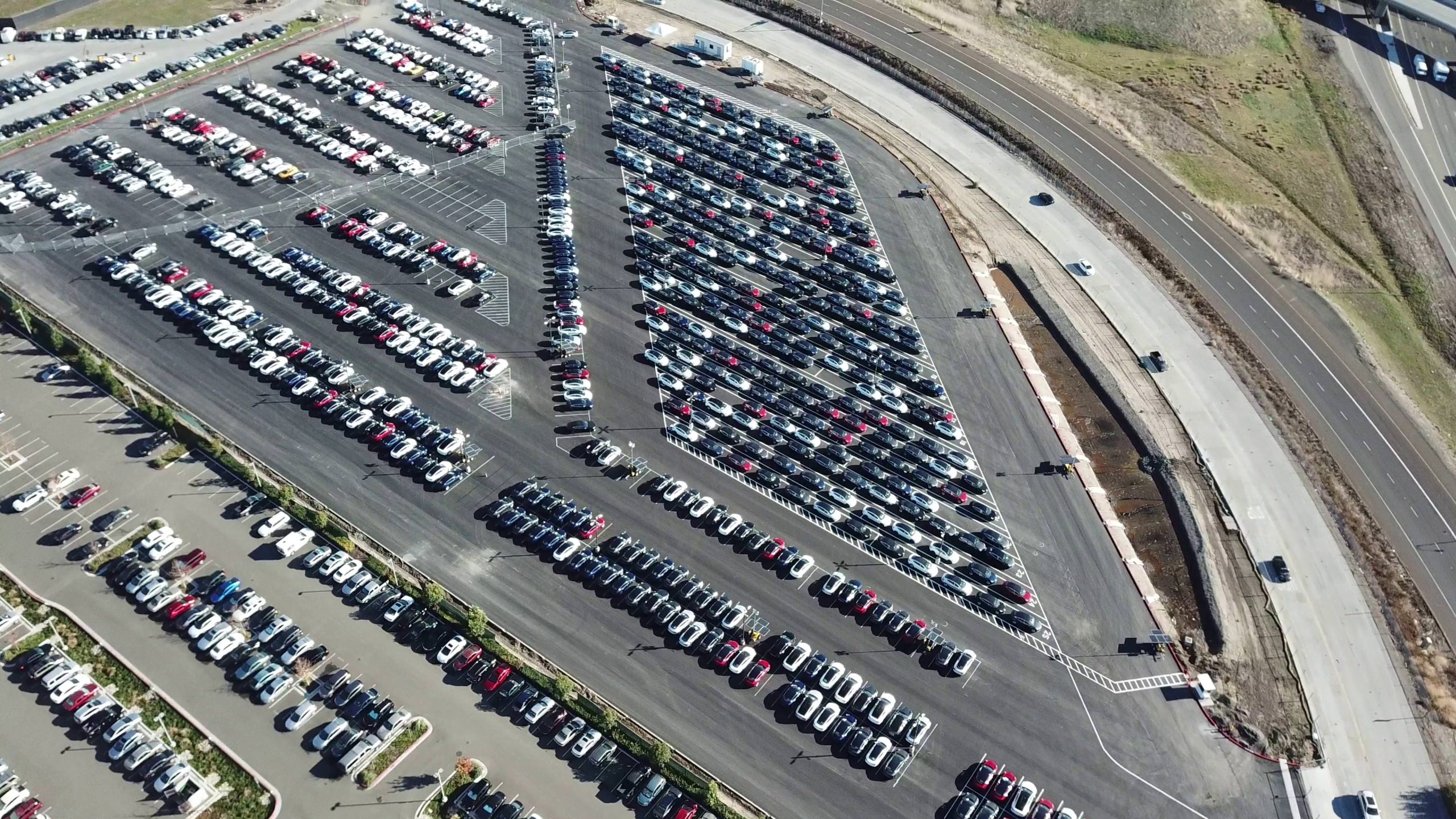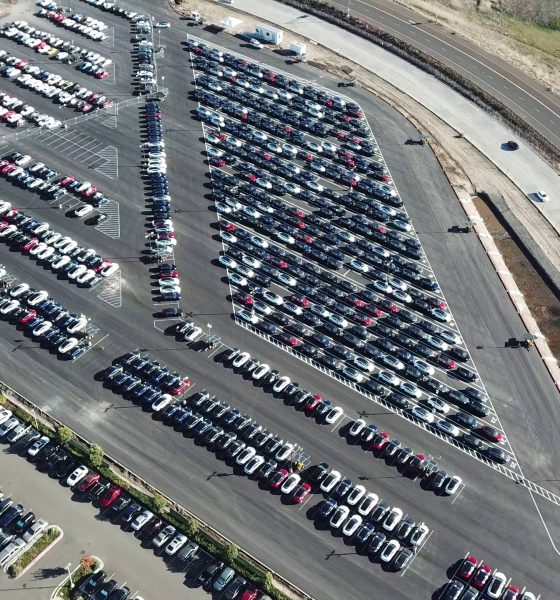

Investor's Corner
Tesla registers 5170 new Model 3 VINs as online tracker hits 20k milestone
In what appears to be another record batch, Tesla has registered 5,170 new Model 3 VINs. The news comes as Bloomberg’s online production tracker displayed yet another milestone, suggesting that the 20,000th Model 3 has been manufactured by Tesla.
News of the new batch of VIN registrations came on Monday, with Twitter’s Model 3 watchdog account @Model3VINs posting the update on its official page. According to the group, the highest VIN of Tesla’s Model 3 line now stands at 33,466, suggesting that a ramp is happening in the Fremont factory.
#Tesla registered 5,170 new #Model3 VINs. Highest VIN is 33466. https://t.co/3cJojvzlRv
— Model 3 VINs (@Model3VINs) April 23, 2018
Just recently, a leaked email from Elon Musk to his employees suggested that the Model 3 line is shifting to a 24/7 schedule in order to raise its production output. According to Musk’s email, the Model 3 line would be stopping for a few days in order to roll out a “comprehensive set of upgrades” which would allow the company to start hitting the 3,000-4,000 a week mark. This, however, would just be the beginning.
Musk’s leaked email further teased another planned shutdown sometime in May, in order to implement yet another set of upgrades for the Model 3 production line. The enhancements on May would enable Tesla to “unlock” a production capacity of up to 6,000 vehicles per week. Musk further noted in his message to employees that the company would be targeting a rate of 6,000 Model 3 per week by June instead, to provide a margin of error from the original 5,000-a-week goal.
Apart from the more than 5,000 new Model 3 VINs that Tesla recently filed, another apparent sign of a production ramp is the current status of Bloomberg’s online tracker. Over the past weeks, the publication’s tracker, which utilizes data from US government sources, social media reports, and direct communication with Tesla owners, has shown a notable uptick in the pace of the Model 3 line.
Bloomberg’s Model 3 tracker as of 4/23/2018. [Credit: Bloomberg]
Just recently, the tracker hit yet another milestone, breaching the 20,000-mark. As of Monday morning, the online tracker estimates that Tesla has produced 20,014 Model 3 so far, with a production rate of 2,616 vehicles per week.
Overall, a ramp in the production of the Model 3 at this point would be a statement for the Elon Musk-led company. Tesla, after all, is battling naysayers from all sides, many of which are doubting the company’s ability to raise the Model 3’s production to 5,000 a week by the end of the second quarter. Among this is Goldman Sachs, which suggested in a recent analyst note that Tesla would only sustain a pace of about 1,400 Model 3 per week this quarter.
Last week, however, Morgan Stanley adopted a friendlier stance on the electric car maker. In a note, the firm’s analysts led by Adam Jonas maintained their Neutral rating on Tesla’s stocks. The Morgan Stanley team, however, slightly lowered their price target from $379 to $376 per share.
As of writing, Tesla stock (NASDAQ:TSLA) is trading down 1.55% at $285.77 per share.

Investor's Corner
Tesla stock closes at all-time high on heels of Robotaxi progress

Tesla stock (NASDAQ: TSLA) closed at an all-time high on Tuesday, jumping over 3 percent during the day and finishing at $489.88.
The price beats the previous record close, which was $479.86.
Shares have had a crazy year, dipping more than 40 percent from the start of the year. The stock then started to recover once again around late April, when its price started to climb back up from the low $200 level.
This week, Tesla started to climb toward its highest levels ever, as it was revealed on Sunday that the company was testing driverless Robotaxis in Austin. The spike in value pushed the company’s valuation to $1.63 trillion.
Tesla Robotaxi goes driverless as Musk confirms Safety Monitor removal testing
It is the seventh-most valuable company on the market currently, trailing Nvidia, Apple, Alphabet (Google), Microsoft, Amazon, and Meta.
Shares closed up $14.57 today, up over 3 percent.
The stock has gone through a lot this year, as previously mentioned. Shares tumbled in Q1 due to CEO Elon Musk’s involvement with the Department of Government Efficiency (DOGE), which pulled his attention away from his companies and left a major overhang on their valuations.
However, things started to rebound halfway through the year, and as the government started to phase out the $7,500 tax credit, demand spiked as consumers tried to take advantage of it.
Q3 deliveries were the highest in company history, and Tesla responded to the loss of the tax credit with the launch of the Model 3 and Model Y Standard.
Additionally, analysts have announced high expectations this week for the company on Wall Street as Robotaxi continues to be the focus. With autonomy within Tesla’s sights, things are moving in the direction of Robotaxi being a major catalyst for growth on the Street in the coming year.
Elon Musk
Tesla needs to come through on this one Robotaxi metric, analyst says
“We think the key focus from here will be how fast Tesla can scale driverless operations (including if Tesla’s approach to software/hardware allows it to scale significantly faster than competitors, as the company has argued), and on profitability.”

Tesla needs to come through on this one Robotaxi metric, Mark Delaney of Goldman Sachs says.
Tesla is in the process of rolling out its Robotaxi platform to areas outside of Austin and the California Bay Area. It has plans to launch in five additional cities, including Houston, Dallas, Miami, Las Vegas, and Phoenix.
However, the company’s expansion is not what the focus needs to be, according to Delaney. It’s the speed of deployment.
The analyst said:
“We think the key focus from here will be how fast Tesla can scale driverless operations (including if Tesla’s approach to software/hardware allows it to scale significantly faster than competitors, as the company has argued), and on profitability.”
Profitability will come as the Robotaxi fleet expands. Making that money will be dependent on when Tesla can initiate rides in more areas, giving more customers access to the program.
There are some additional things that the company needs to make happen ahead of the major Robotaxi expansion, one of those things is launching driverless rides in Austin, the first city in which it launched the program.
This week, Tesla started testing driverless Robotaxi rides in Austin, as two different Model Y units were spotted with no occupants, a huge step in the company’s plans for the ride-sharing platform.
Tesla Robotaxi goes driverless as Musk confirms Safety Monitor removal testing
CEO Elon Musk has been hoping to remove Safety Monitors from Robotaxis in Austin for several months, first mentioning the plan to have them out by the end of 2025 in September. He confirmed on Sunday that Tesla had officially removed vehicle occupants and started testing truly unsupervised rides.
Although Safety Monitors in Austin have been sitting in the passenger’s seat, they have still had the ability to override things in case of an emergency. After all, the ultimate goal was safety and avoiding any accidents or injuries.
Goldman Sachs reiterated its ‘Neutral’ rating and its $400 price target. Delaney said, “Tesla is making progress with its autonomous technology,” and recent developments make it evident that this is true.
Investor's Corner
Tesla gets bold Robotaxi prediction from Wall Street firm
Last week, Andrew Percoco took over Tesla analysis for Morgan Stanley from Adam Jonas, who covered the stock for years. Percoco seems to be less optimistic and bullish on Tesla shares, while still being fair and balanced in his analysis.

Tesla (NASDAQ: TSLA) received a bold Robotaxi prediction from Morgan Stanley, which anticipates a dramatic increase in the size of the company’s autonomous ride-hailing suite in the coming years.
Last week, Andrew Percoco took over Tesla analysis for Morgan Stanley from Adam Jonas, who covered the stock for years. Percoco seems to be less optimistic and bullish on Tesla shares, while still being fair and balanced in his analysis.
Percoco dug into the Robotaxi fleet and its expansion in the coming years in his latest note, released on Tuesday. The firm expects Tesla to increase the Robotaxi fleet size to 1,000 vehicles in 2026. However, that’s small-scale compared to what they expect from Tesla in a decade.
Tesla expands Robotaxi app access once again, this time on a global scale
By 2035, Morgan Stanley believes there will be one million Robotaxis on the road across multiple cities, a major jump and a considerable fleet size. We assume this means the fleet of vehicles Tesla will operate internally, and not including passenger-owned vehicles that could be added through software updates.
He also listed three specific catalysts that investors should pay attention to, as these will represent the company being on track to achieve its Robotaxi dreams:
- Opening Robotaxi to the public without a Safety Monitor. Timing is unclear, but it appears that Tesla is getting closer by the day.
- Improvement in safety metrics without the Safety Monitor. Tesla’s ability to improve its safety metrics as it scales miles driven without the Safety Monitor is imperative as it looks to scale in new states and cities in 2026.
- Cybercab start of production, targeted for April 2026. Tesla’s Cybercab is a purpose-built vehicle (no steering wheel or pedals, only two seats) that is expected to be produced through its state-of-the-art unboxed manufacturing process, offering further cost reductions and thus accelerating adoption over time.
Robotaxi stands to be one of Tesla’s most significant revenue contributors, especially as the company plans to continue expanding its ride-hailing service across the world in the coming years.
Its current deployment strategy is controlled and conservative to avoid any drastic and potentially program-ruining incidents.
So far, the program, which is active in Austin and the California Bay Area, has been widely successful.








